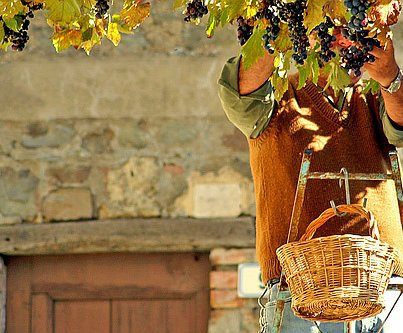 In Italy the grape harvest (la vendemmia) begins in the early to mid-Fall usually during September and October. Every region of Italy grows grapes and the cities, towns and villages across the country celebrate the harvest with grape festivals (sagre) making Autumn one of the best times and seasons to see and savor Italy. I will not be in Italy this year until the end of October when my friends at Tenuta Vitanza near Montalcino in Tuscany tell me I will only be able to pick grape juice! Che peccato! My only vendemmiathis year will be virtual.
In Italy the grape harvest (la vendemmia) begins in the early to mid-Fall usually during September and October. Every region of Italy grows grapes and the cities, towns and villages across the country celebrate the harvest with grape festivals (sagre) making Autumn one of the best times and seasons to see and savor Italy. I will not be in Italy this year until the end of October when my friends at Tenuta Vitanza near Montalcino in Tuscany tell me I will only be able to pick grape juice! Che peccato! My only vendemmiathis year will be virtual.
Here are a few favorite Italian grapes that are part of my virtual pick.
Albana: found in Emilia Romagna; Albana di Romagna a rich, sweet passito wine made from partly dried grapes (on the vine, in small boxes, on wooden grates, or indoors using air);I first had this wine after dinner at Trattoria La Romantica in Ferrara for an out-of-body wine experience
Barbera: the third most planted grape in Italy, popular because of its low tannins and high acidity making it a perfect pairing for tomato sauced pasta
Bonarda: classic grape grown in Piedmonte, Lombardia and Emilia Romagna; in the Oltrepò Pavese for Colli Piacentini DOCs and the killer Colli Piacentini Gutternio; Bonardo Oltrepo Pavese was our cousin Roberto’s favorite wine; deep. ruby-red purple, bright and cheerful, with an aroma of violets and a taste of blackberries, easy to drink
Dolcetto: another Piedmontese grape; dark, purple skinned; the everyday wine of the region
Nebbiolo: grows in the foggy mist of the Langhe region of Piedmonte (nebbia is the Italian word for fog) used in the making of two of the classic bold wines of Italy, Barolo and Barberesco, the king and queen of Italian wines; wines with age
Malavasia: grown in the Friuli-Venezia Giulia region; the vine was introduced to the area by Venetian merchants who brought cuttings from Greece; my favorite is the sweet Arquatum-Passito di Malvasia that I have had at Ristorante Don Ferdinando in Castell’Arquato with my friend Rita
Sagrantino: the main red grape of Umbria used to make the most excellent DOCG Sagrantino di Montefalco; “la dolce vita” squared (to the highest degree); high regard for the wine of this grape begins with an afternoon spent in a wine bar in Umbria with my friends, Luca and Luigi over a bottle of Montefalco Sagrantino
Sangiovese: the iconic Italian grape used to make Chianti Classico; follow the Trail of the Black Rooster (Gallo Nero); found in Brunello, Morellino, Super Tuscans and Carmignano with wine memories made at Tenuta di Capezzana with the Contini-Bonacossi family
Trebbiano: grape used to make Vin Santo, the wine of the saints; grapes are held in baskets then strung together on cane stands where they are dried for several months in the vinsantaie( a large ventilated room) then fermented and matured for over 4 years in caratelli (small chestnut barrels)
Teroldego:grown primarily in the northeastern region of Trentino-Alto Adige/Südtirol, Italy; the Dolomites, the Ice man, Italian/German food and a wine called Tyrolean Gold; my wine memories of Teroldego are aromatic, heady, wild flowers and juicy fruit from a glass with my family at the Hotel Alpino in the Val di Fiemme
Vernaccia: white grape used in a DOCG in San Gimignano, Tuscany
